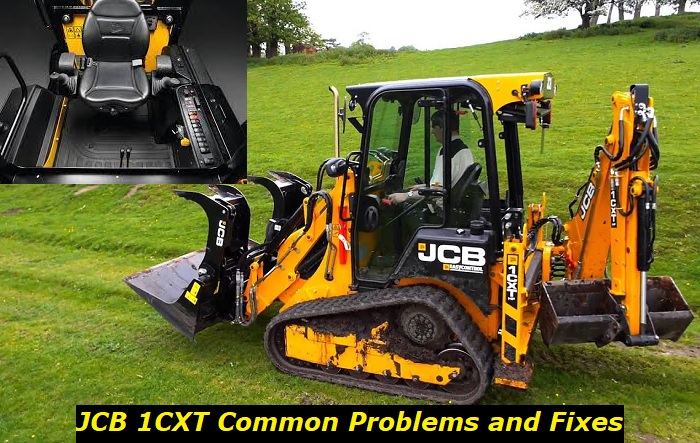JCB 1CXT: Problems, Durability, Repairs
JCB is a less-known name, but even unknown companies can still produce stellar equipment. The question today is whether the JCB 1CXT is worthy of this title, or if it's better to avoid it altogether.
Depending on the angle you first look at it, you could be forgiven for thinking that the JCB 1CXT is either a skid steer or a backhoe loader. In reality, this machine is a combination of both, marketed by JCB as the world's first skid steer backhoe.
While it isn't as compact as many other skid loaders, it makes up for this with its wide versatility. This machine has both a backhoe and a loader, allowing it to carry out a wide range of operations.
In this article, we'll take a look at what the JCB 1CXT is capable of. We'll also discuss its durability and what problems you'll need to repair. Let's get started.

What Should You Know About the JCB 1CXT?
The machine attempts to be a fusion between a backhoe and a skid steer. It makes some compromises to get this to work, particularly on the skid steer side. However, in the end, it does work. The JCB 1CXT makes for a passable skid steer and an excellent backhoe.
- Smooth controls
Many JCB 1CXT operators will speak highly of the smoothness of the machine's controls. The 1CXT uses twin joysticks mounted to the driver's left and right. The left joystick controls the machine's motion, while the right joystick controls the loader.
If you're an operator that's specific about your controls or can't stand unresponsive or stiff controls, then the 1CXT is worth considering.
- Wide variety of attachments
One of the advantages of the 1CXT is that you have the option of using a wide variety of skid steer attachments. Almost any attachment type you require can be fitted into the attachment points at the front of the machine.
- Side access
The JCB 1CXT has an easily accessible side entrance. Not only does this make it easier for operators to enter and leave the cab, but it also reduces the risk of worksite accidents from having to climb over the bucket.
- Light Footprint
The JCB 1CXT has rubber tracks that help it get as much power to the surface as possible. This helps it maintain its traction even on wet and slippery terrain. Despite that, the machine weighs under 10,000 pounds and has a light footprint. This means that the tracks perform minimal damage to the surface, and you can confidently bring it anywhere.
- Vertical Stabilizers
The JCB 1CXT has vertical stabilizers that press down directly into the ground rather than folding out. This helps the machine maintain a narrow profile so you can stay stable and compact at the same time.
- Quick Swivel
The operator's sweat can swivel between loader operation and backhoe operation with the pull of a lever. This means that you can easily switch modes without needing to get down from the machine to manually swivel the chair. The seat can also swivel to a 45-degree angle for easier entrance and exit.
How Long Will the JCB 1CXT Last?
The JCB 1CXT is a well-designed machine. An important thing to remember is that this machine is optimized for increased productivity. This means that JCB has done everything it can to minimize the amount of downtime you'll experience.
To accomplish this, the JCB 1CXT has long service intervals, requiring servicing only once every 500 hours. This keeps your machine in good working order, while also keeping it on the site working for as long as possible.
If you take good care of your loader and deal with any strange sounds or problems as soon as they come up, you can expect a reasonably long life from it. A well-maintained JCB 1CXT will last 6000-6500 hours before any major replacements will need to be made.
Maintaining this machine is made rather simple by many of the considerations that JCB worked into the design. The loader's engine is easily accessed from ground level by opening the one-piece hood and taking out the removable side panels.
Most of the engine's maintenance and daily checks can easily be done from one side. This means that even the laziest operator will find it easy to perform regular daily checks.
Problems with the JCB 1CXT
We've already extolled the many virtues of this backhoe. Having a machine that functions as both a backhoe and skid loader is a real benefit to any site, even if the machine isn't quite so compact. However, there are still some issues that need to be brought to light when discussing this machine.
You'll need to be well informed about what can go wrong if you're purchasing this machine, so let's take a look at some of the problems the 1CXT faces.
1) Ineffective Bucket
One of the major trade-offs of going for this backhoe instead of a skid steer is that the front loader is not quite as effective.
- The bucket doesn't lift up quite as high as a normal skid steer would.
- The stock bucket also has a lower capacity than a typical skid steer bucket. While the machine has an impressive lifting ability, the original bucket won't let you carry much of anything. This can easily be fixed if you invest in a new bucket with a larger capacity.
2) Low-Quality Parts
Another common complaint about the ICXT is one that's shared with many JCB machines. Many operators find that while the loader is generally well-built, many parts of the machine are built with cheap components that fail or break down quickly.
Many of these components are non-critical parts like hinges, handles, and lights, so you won't experience much downtime from them. However, replacing these parts can get annoying with time, even if they're inexpensive.
3) Hydraulic Leaks
Being something of a hybrid skid loader/backhoe, the JCB 1CXT has more hydraulics than your typical loader. Despite the fact that the hydraulic system is well-built, it means that there is a much higher chance of something going wrong with it.
What Repairs Will the JCB 1CXT Need?
The JCB 1CXT is a solidly built machine. It tends not to fall apart or need frequent repairs, especially when it's maintained as directed. If maintenance is neglected, or you fail to carry out daily checks, you might find yourself needing to make a few repairs.
1) Change Filters
JCB has made this easier by keeping all of the filters on a single side. Not only does this make servicing quick and easy, but it also makes daily inspections much less of a chore.
Backhoes in the 1CXT are often used in dirty and dusty environments where mud, sand, and grit easily make their way into the engine compartment or fluids. This means your filters are often working overtime to keep the fluids clean and your engine safe.
If clogged filters aren't replaced on time, you might notice a loss of power to the engine or hydraulics.
2) Replace Damaged Parts
JCB machines have a lesser-known reputation for using low-quality parts. This means you might find a door handle that stops working, a door hinge that gets stuck, or a mirror that won't stay where it should.
Most of the time these aren't high-priority repairs, but you'll still want to get them fixed so your beloved loader doesn't turn into a rust bucket.
3) Fix Hydraulic Leaks
Developing hydraulic leaks is an eventual occurrence when you own a skid loader or backhoe. Having a machine that combines these two systems means that there's a lot more that could go wrong. There's also a lot more that you'll need to inspect.
You'll need to inspect the hydraulic hoses that run along the boom and loader arms. Look for any signs of wear, cracking, or damage on the hoses, as well as traces of hydraulic fluid.
You should also inspect the hydraulic cylinders that power the boom and loader arms. They can often be damaged through poor technique or by overloading.
Bottom Line
The JCB 1CXT is definitely an impressive machine. There are very few downsides to it, and it comes with plenty of features designed to make your work much easier.
It's a highly versatile loader that you can rely on to fill the roles of both a skid steer and a backhoe. That means it'll save you plenty of time and money since you won't need to transport two machines to a site. A flick of a lever will swivel the seat and switch between backhoe and skid steer mode.
Just stay diligent with your walkarounds, and you shouldn't have any serious issues with this loader.
However, if you neglect maintenance, you're likely to run into problems, particularly with the hydraulics. Having both a loader and a backhoe means there are almost twice as many hydraulics for something to go wrong with.
If you need a compact backhoe or skid steer, the JCB 1CXT has our vote. It effectively combines the best of both worlds into one compact, efficient machine.

Add comment